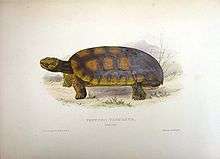Thomas Bell (zoologist)
| Thomas Bell | |
|---|---|
 | |
| Born |
October 11, 1792 Poole, England |
| Died |
March 13, 1880 (aged 87) Selborne, England |
| Author abbrev. (zoology) | Bell |
Thomas Bell FRS (11 October 1792 – 13 March 1880) was an English zoologist, surgeon and writer, born in Poole, Dorset, England.
Career

Bell, like his mother Susan, took a keen interest in natural history which his mother also encouraged in his younger cousin Philip Henry Gosse. Bell left Poole in 1813 for his training as a dental surgeon in London. He combined two careers, becoming Professor of Zoology at King's College London in 1836 (on the strength of amateur research) and lecturing on anatomy at Guy's Hospital. He became a fellow of the Royal College of Surgeons in 1844. He was President of the Linnean Society in 1858.
Bell was at the heart of the scientific establishment and when Charles Darwin returned to London from the Beagle expedition on 2 December 1836, Bell was quick to take on the task of describing the reptile specimens.[1] He was also entrusted with the specimens of Crustacea collected on the voyage. He was the authority in this field; his book British Stalke-eyed Crustacea is a masterwork. He played a significant part in the inception of Darwin's theory of natural selection in March 1837 when he confirmed that the giant Galápagos tortoises were native to the islands, not brought in by buccaneers for food as Darwin had thought.[2] He supported the arrangements for publication of Zoology of the Voyage of H.M.S. Beagle, but then was very slow to make progress on the work, and though the first parts of work were published in 1838, Bell's contribution on reptiles (Part 5) was published in two numbers, in 1842 and 1843,[3] and he subsequently failed to take any action on the Crustacea.[4]
As President of the Linnean Society he chaired the meeting on 1 July 1858 at which Darwin and Alfred Russel Wallace first published their theories on natural selection in the joint presentation of papers On the Tendency of Species to form Varieties; and on the Perpetuation of Varieties and Species by Natural Means of Selection. He apparently disapproved, and in his annual presidential report presented in May 1859 wrote that "The year which has passed has not, indeed, been marked by any of those striking discoveries which at once revolutionize, so to speak, the department of science on which they bear".[5][6]
In his seventieth year Bell retired to Selborne, where he took a keen interest in the amateur naturalist Gilbert White. In 1877 he published a new edition of White's book The Natural History of Selborne. Bell died at Selborne in 1880.
Works

- Thomas Bell. A Monograph of the Testudinata 1832–1836 – summarizes all the world's turtles, living and extinct. The forty plates are by James de Carle Sowerby and Edward Lear.
- Thomas Bell. A History of the British Stalk-eyed Crustacea 1844–1853. John Van Voorst, Paternoster Row, London.
References
- ↑ Desmond & Moore 1991, p. 204.
- ↑ Desmond & Moore 1991, p. 220.
- ↑ The Complete Work of Charles Darwin Online: The Zoology of the Voyage of H.M.S. Beagle – bibliography by Freeman, R. B. (1977) and links to online texts and images of each of the nineteen numbers.
- ↑ Keynes 2000
- ↑ Browne 2002, pp. 40–42
- ↑ Keynes 2000
Bibliography
- Browne, E. Janet (1995), Charles Darwin: vol. 1 Voyaging, London: Jonathan Cape, ISBN 1-84413-314-1
- Browne, E. Janet (2002), Charles Darwin: vol. 2 The Power of Place, London: Jonathan Cape, ISBN 0-7126-6837-3
- Desmond, Adrian; Moore, James (1991), Darwin, London: Michael Joseph, Penguin Group, ISBN 0-7181-3430-3
- Keynes, Richard (ed.) (2000), "Specimen Lists", Charles Darwin's zoology notes & specimen lists from H.M.S. Beagle., Cambridge: Cambridge University Press
External links
- A History of the British Stalk-eyed Crustacea, Internet Archive
- A Monograph of the Testudinata, Rare Book Room